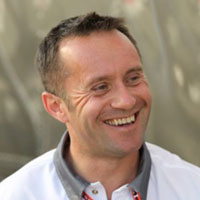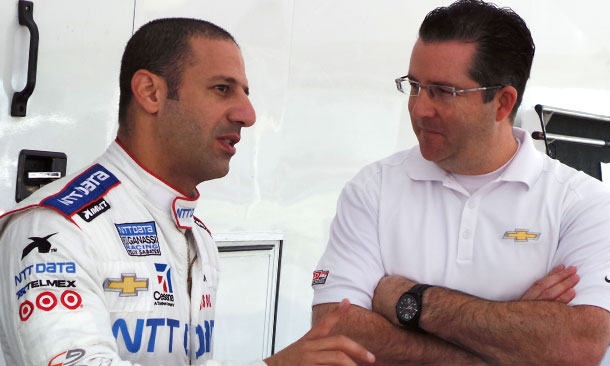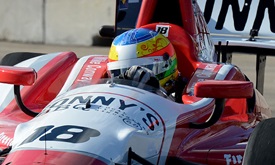Even closer competition? Yes, through twin turbos
JAN 02, 2014
Year 3 of manufacturer competition is on deck with a twist as INDYCAR has mandated that Chevrolet and Honda utilize an engineered for racing twin turbo supplied by BorgWarner on their 2.2-liter, V-6 engines for the 2014 IndyCar Series season.
Chevrolet, in partnership with Ilmor Engineering, re-entered the IndyCar Series in 2012 with a twin turbo engine, while Honda Performance Development elected to use a single turbo. The California-based group has conducted two tests on the Sebring International Raceway short course and one on the 2-mile Auto Club Speedway oval as it prepares for the season-opening Firestone Grand Prix of St. Petersburg on March 28-30.
 “We had evolved the 2013 spec engine with a single turbo to a very high level of development so we had a very high bar that we had set for ourselves in terms of drivability and response and those kinds of things,” HPD technical director Roger Griffiths (left) said. “We were pleasantly surprised by the rate at which we reached the same sort of level of performance with the 2014 engine given that it was all kind of new.
“We had evolved the 2013 spec engine with a single turbo to a very high level of development so we had a very high bar that we had set for ourselves in terms of drivability and response and those kinds of things,” HPD technical director Roger Griffiths (left) said. “We were pleasantly surprised by the rate at which we reached the same sort of level of performance with the 2014 engine given that it was all kind of new.
“We started out with a strict test plan. We tried not to straight out of the gate get too distracted if say the initial feedback from the driver is not great. We’d rather not jump to item 10 on the test list; we’d like to go item 1, 2 and 3 and step our way through. While the driver might not think he’s making much progress, we actually learn a lot about what’s going on.
“We were pleased with the mechanical installation of the engine and the twin turbo. It worked as intended and we came away from the running with a lot of data and driver feedback.”
Simon Pagenaud, who placed third in the 2013 championship in the No. 77 Honda-powered Schmidt Hamilton Motorsports car and initially tested the “2014-esque” engine at Auto Club Speedway in September, traveled to HPD’s headquarters after Thanksgiving to confer with design and development engineers.
“Simon came to HPD and spent a lot of time with our development engineers just talking about his experiences of the 2013 season and that’s really good for our guys,” Griffiths said. “Our guys could come back from a test and say, ‘OK, these are the top five complaints and what needs fixed.’ But it’s our translation of what the driver is saying to the design engineers. Sitting down with 10 of our young engineers they quickly get past the shock of an IndyCar driver sitting down with them in the meeting room and it’s just another person trying to do a job.
“They’re hearing from the person driving the car what they want. It really helps our relationship with the drivers. Simon gave us some good pointers.”
Development continues for both manufacturers with a couple of hard stops – homologation of components at the end of January, an Open Test scheduled for mid-March at Barber Motorsports Park and the opening race on the 1.8-mile street circuit.
“But there are a lot of things – the calibration of the engine and those kinds of things are ever evolving,” Griffiths said. “We will continue to push that; we want to get out and be running with Round 1 or Race 1 of the specifications certainly by the Open Test. We have to make sure that when we turn up at St. Pete we are as prepared as we can be, that we’ve done everything and ticked every box we can imagine and avoid the performance issues that we had last year. It’s sometimes these challenging days that we learn the most.”
HPD’s successful LMP2 sports car program has incorporated a twin turbo since 2011 and Griffiths said it gave the company a head start for 2012 “in terms of us working with a turbo-charged engine rather than the sports car has led the IndyCar development.”
“The engines are different; (the LMP2) is effectively a mini-van engine so they are V-6s and twin turbos but that’s about where the comparison ends,” Griffiths said. “What we’ve learned through the IndyCar program we’ve been able to apply to our sports car program. Our LMP2 customers are now benefitting from our IndyCar program.”
Chevrolet has won the past two manufacturer titles. In 2013, the championship came down to the final few laps of the 500-mile race at Auto Club Speedway. Griffiths and Chris Berube, the IndyCar program manager for Chevrolet, expect another exciting season of close competition.
“You always want to come into a season with a full head of steam,” Berube said. “You want to have new ideas and learn from the past areas to improve on. When we had the single versus twin I think there were advantages of each. We originally went with twin because we believed there was a better application of that; now with Honda also using twin we’re more equal in terms of a spec list. We still have the execution that’s different.
“I think we have a good understanding of the twin turbo application and that in itself will be an advantage initially. (The competition) pushes the engineers to gain a competitive advantage and that’s what it’s all about. It certainly makes it more exciting for the fans.”
Added Griffiths: “A lot of people said, ‘What were you thinking?’ when we went with the single turbo and a lot of people said, ‘Oh, they’re just focused on the Indy 500’ and a single turbo is never going to work on a street course or road course because the drivability is going to be horrendous. But if you look at the race results from last year we actually struggled at Indy and we won at all the racetracks where everybody said the single turbo was not going to go in the right direction. It’s just the way you do it.
“I think a lot of the things we learned from making a single turbo drivable gave us an advantage when we went to a twin turbo engine because we had to work hard to make the single turbo work. I think it’s given us really good insight into how to approach the twin turbo development.”

















